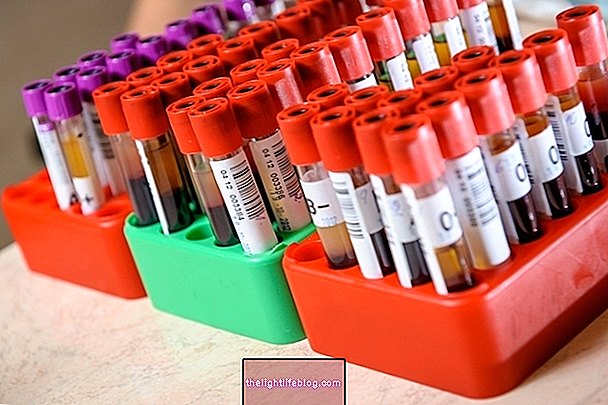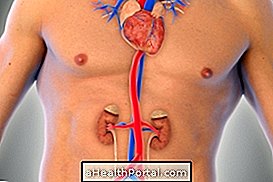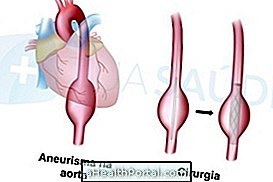The Doppler ultrasound is a type of ultrasound, with specific techniques, which allows the colored visualization of the blood flow in the arteries and veins of the body, helping to verify the functioning of tissues, such as the walls of the heart, nerves and brain.
It is a type of non-invasive test, that is, it does not use needles and does not need anesthesia to be done, and it is performed by a radiologist, who will pass a gel transducer, which is a small part of the ultrasound device, in the body site to be examined.
Through the Doppler echocardiography, it is possible to diagnose various diseases such as atherosclerosis, vasculitis and aneurysms, which is why it is often indicated by the cardiologist or neurologist. However, this examination is also indicated by obstetricians in order to check the baby's health conditions during pregnancy.

What is it for
Doppler ultrasound is a type of ultrasound used to check blood flow in veins and arteries, the heart, brain and even the lower limbs. Thus, this exam can be indicated for the following situations:
- Detect obstructions by fat in the arteries or veins;
- Locate blood clots in the veins of the arm or leg;
- Check if there is any dilation of the wall of the veins or arteries;
- Analyze the results of surgeries performed on the heart;
- Evaluate the characteristics of varicose veins.
In addition, the Doppler scan can also help to check the blood pressure inside the arteries, showing the amount of blood flowing in the blood vessels and can be done as an alternative to other more invasive tests, such as angiography, which involves the injection of contrast in the vein.
This test can also be performed on children and is generally recommended by the pediatrician to assess whether there is any malformation in the heart or to assist in the placement of a central venous catheter. See more what is a central venous catheter and in what cases it is indicated.
How is done
The ecodoppler exam is performed by a radiologist in a room in a unit, or diagnostic center, and does not require anesthesia or contrast in the vein, in addition to the fact that no radiation is used.
In order to do the exam it is necessary for the person to put on an apron and lie on a stretcher. Then the doctor will apply a gel and move a transducer through the skin, which is a small device with which it will be possible to view the internal parts of the body, such as veins and arteries. This does not cause pain or discomfort.
The doctor will view the images on a computer screen and analyze the structures of the body, and after a few days, a report will be issued with the description of what was found in the examination and this report must be delivered to the doctor who requested it.
Exam preparation
In most cases, no specific care is needed to perform the test, however, people who use drugs that alter blood pressure or who smoke, should inform the doctor who will do the test, as these situations can increase the flow of blood in the veins and arteries of the body.
What are the types of Doppler Doppler
Depending on the part or structure of the body that the doctor wants to be analyzed, the exam can be:
- Fetal echocardiography: performed during pregnancy, consists of the baby's cardiac evaluation;
- Lower limb echocardiography: used to analyze veins and arteries in the legs;
- Ecodoppler of upper limbs: consists of checking the condition of the veins and arteries of the arms;
- Carotid echodoppler: indicated to check the vein that supplies blood to the head region;
- Ecodoppler of renal arteries: recommended for analysis of kidney arteries and veins;
- Transcranial Doppler: recommended to assess the veins and arteries of the brain;
- Thyroid echocardiography: is the type used to check the blood flow in the thyroid.
These specific types of Doppler echocardiography can be requested when consulting with a cardiovascular doctor or neurologist, but they can also be indicated for people who are admitted to a hospital with suspicion of some disease or disorder.

Main diagnosed diseases
Doppler ultrasound, or ultrasound doppler, can be indicated by a cardiovascular doctor, neurologist or nephrologist to investigate and diagnose some diseases such as:
1. Atherosclerosis
Atherosclerosis is a disease that occurs due to the accumulation of fatty plaques, or atheromas, in the part of the arteries of the heart and that if left untreated can block the flow of blood and lead to the appearance of serious complications such as acute myocardial infarction and accident cerebral vascular system.
Echocardiography is a type of test widely used to investigate this disease, however, the cardiologist may order other tests such as angiography and cardiac catheterization. After diagnosing this change, the doctor will recommend the most appropriate treatment based on changes in habits and medicines. See more other treatment options for atherosclerosis.
2. Vasculitis
Vasculitis is an alteration caused by an inflammation of the blood vessels in the body and can cause symptoms such as red patches on the skin, tingling or loss of sensation in the hands or feet, joint pain and fever. This disease can be caused by other conditions such as infections, autoimmune diseases and cancer and, in some cases, lead to complications such as bleeding.
The rheumatologist should be consulted in case of suspected vasculitis, and he may indicate an echocardiograph to confirm the diagnosis. The treatment of this disease is recommended by the doctor according to the severity and location of the inflammation of the blood vessels. Check out other tests that can be done to confirm the diagnosis of vasculitis and which treatment.
3. Aneurysms
Aneurysms can arise due to an increase in the pressure with which the blood passes into a blood vessel, which leads to the formation of a dilation of the vein or artery wall. This dilation can occur in blood vessels of the heart, brain or parts of the body, such as the abdominal aorta, for example.
The symptoms depend on the location of the aneurysm, and people who suffer from this alteration may have severe pain in the area, difficulties in walking, tingling in the head, blurred vision and even seizures and should seek emergency care from a hospital. Check out more the main symptoms of cerebral and aortic aneurysm.
4. Deep venous thrombosis
Deep vein thrombosis is a situation that occurs due to an obstruction of a deep vein in the leg, thigh or abdomen, compromising the flow of blood and, in most cases, causes swelling, severe pain and purple coloration in the leg, for example.
Some risk factors are related to the onset of deep venous thrombosis such as cancer, major surgery, use of oral contraceptives and little movement of the body, and the diagnosis is made by means of echocardiography. Often, hospitalization is necessary for the treatment of this alteration, which is based on the use of anticoagulant medications, such as heparin. Learn how to prevent thrombosis in the leg.
5. Renal artery stenosis
Renal artery stenosis is defined as the narrowing of the main kidney artery because of fatty plaques, a blood clot or a tumor, and the diagnosis of this alteration is made through exams such as angiography and renal Doppler.
The treatment of renal artery stenosis is indicated by the nephrologist and consists of catheterization, surgery and use of anticoagulant and thrombolytic drugs. Often, this treatment must be done with the person admitted to a hospital to receive the medication through the vein and must be started as soon as possible to avoid complications such as pulmonary edema.
Was this information helpful?
Yes No
Your opinion is important! Write here how we can improve our text:
Any questions? Click here to be answered.
Email in which you want to receive a reply:
Check the confirmation email we sent you.
Your name:
Reason for visit:
--- Choose your reason --- DiseaseLive betterHelp another personGain knowledge
Are you a health professional?
NoMedicalPharmaceuticalsNurseNutritionistBiomedicalPhysiotherapistBeauticianOther
Bibliography
- LEE, Whal. General principles of carotid Doppler ultrasonography. Ultrasonography. VOL.33, N.1. 11-17, 2014
- NAREDO, E .; MONTEAGUDO, I. Doppler techniques. Clin Exp Rheumatol. Vol.32, n. 1. 12-9, 2014
- EVANS, David H. et al. Ultrasonic color Doppler imaging. Focus interface. Vol.1, n.4. 490-502, 2011
- RADIOLOGICAL SOCIETY OF NORTH AMERICA. Ultrasound - Vascular. Available in: . Accessed on Dec 04, 2019
- BRAZILIAN SOCIETY OF RHEUMATOLOGY. Vasculitis. Available in: . Accessed on Dec 04, 2019
- BMJ BEST PRACTICE. Deep vein thrombosis. Available in: . Accessed on Dec 04, 2019
- FELDMAN, Andre et al. The relationship between renal artery stenosis, arterial hypertension and chronic renal failure. Rev Bras Hipertens. Vol.15, n.3. 181-184, 2008
- ROMUALDO, André P. Doppler without secrets. 1.ed. Rio de Janeiro: Elsevier, 2015.






















